
The Online Newsletter of the Atlanta Recreation and Fun Club for Dogs, Inc.
Spring 1996
Spring 1996 |
|
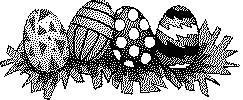
Agility Show and Go March 30 (Saturday) 1-3pm. Mimosa Downs Agility Field. Sponsored by Our Place or Yours Pet Services. $5 first run/$3 subsequent runs. ARF! members receive a 50% discount.
Easter Egg Hunt April 7 (Sunday) 1-2pm. Mimosa Downs Agility Field. ARF!'s 4th Annual Easter Egg Hunt. This event is free to members.
Spring Fun Match April 7 (Sunday) 2-3pm. Mimosa Downs Agility Field. "ARF! sanctioned" fun match for RAD, TAD, and EGAD agility titles.
Agility Classes April 21-May 12 (4 Sundays) 1-3pm. Mimosa Downs Agility Field.
ARF! Agility Clinic for the Chattahoochee Valley Bernese Mountain Dog Club May 18
(Saturday) 9am-12pm. Mimosa Downs Agility Field.
Return to Contents
Dog Shoots Hunter
From the Atlanta Journal-Constitution, January 1996

A cocker spaniel named Rusty stepped on the trigger of a shotgun and blasted 45-year-old Phillip Smith in both legs.
Smith and dog owner John Phillips were hunting near Inez, Kentucky, when the dog stepped on
the gun as Phillips was trying to pull a retrieved bird from the dogs mouth.
Return to Contents
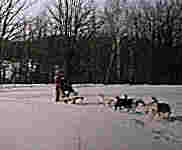

Temperatures Reach -60 Degrees During Weekend Sled Trip
by Amy Matthews
It seemed like a good idea in July, going on an all-women's dogsledding trip in northern Minnesota the next February. My husband could visit with his mother in Minneapolis while I mushed. Id lived in Minneapolis for a few years, so I was used to the cold weather. No problem!
But February arrived and with it came Arctic weather and fierce blizzards and record breaking cold. The day before I was to report to camp, I went to a sporting goods store to buy a few last minute items, and the stores cold weather sports expert said, Youre going to be facing life- threatening conditions so it would be best if you bought these heavy boots. I said, If Im going to be facing life-threatening conditions, it would be best if I stayed home! That night, in Tower, Minnesota, not far from the cabin where I would be staying, the lowest temperature ever recorded in Minnesota was reached - minus 60 degrees. That didnt include the wind chill factor.
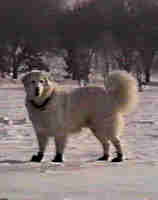 How cold was it? Our own dogs (see Dori, at left, on frozen Lake
Nokomis), who were staying with my husband in Minneapolis, had
seemed to enjoy previous cold weather visits to Minnesota, when the temperatures were only ten
below zero. But this time, they refused to go for walks because of the intense cold, hopping and
holding their paws off the ground, as if they were on a hot griddle. We had to buy boots for them
just so they could go outside and do their business.
How cold was it? Our own dogs (see Dori, at left, on frozen Lake
Nokomis), who were staying with my husband in Minneapolis, had
seemed to enjoy previous cold weather visits to Minnesota, when the temperatures were only ten
below zero. But this time, they refused to go for walks because of the intense cold, hopping and
holding their paws off the ground, as if they were on a hot griddle. We had to buy boots for them
just so they could go outside and do their business.
Mushing was just a whim. Did I have to go? Id wanted to go dogsledding for a long time but never knew anyone other than professional racers could do it. Now here I was, facing on the one hand the vacation of my dreams, and on the other hand, record breaking, life threatening, Arctic cold. And to top it off, this was my first outdoor vacation experience--Ive never even been camping before. This was going to be a heck of an introduction to outdoor sports!
Well, off we went, heading north to the camp site. Dressed in Thermax, caprilene, polypropelene, polar fleece, felt-lined boots, leather mittens and a down-filled jacket, I faced the cold and I had a good time! I was warm enough. And dogsledding is fun!
The first morning the instructor checked the thermometer and announced that we would have to wait until it warmed up before we harnessed the dogs and took off for Paul Bunyan State Park. The thermometer was blinking low, low, low, which, she explained, it did whenever the temperature went below minus 40 degrees (the lowest temperature the thermometer was able to record). A couple hours later, we were told its warmed up to minus 20 degrees, perfectly good weather for dogsledding! so we bundled up and went out into the cold.
We had three teams of dogsleds at the camp and all of the students got the opportunity to harness the dog teams, drive a sled, and be a handler.
The passenger is called the handler and has work to do--pulling up the anchor rope at the beginning of the trip and leaning left or right to help steer the sled. And in case the driver loses control and falls off, the handler is supposed to stand up in the runaway sled and swing around to the drivers position and apply the brake. That scenario sounded like something out of the Perils of Pauline, and I had a hard time imagining myself doing that in real life.
The driver balances on the runners in the back, straddling thin air, and holds onto the handle on the back of the sled. There are no special footholds for your feet, so you just make sure there isnt any slippery snow or ice on the runners, shift your feet and weight around until you feel balanced, and go. The driver wears huge wooly mittens over his or her regular mittens that are the only thing thatll keep your hands warm as the cold air rushes past. The drivers job is to apply brakes when necessary, lean left or right to steer, and tell the dogs gee or haw to turn right or left. But the drivers most important responsibility is to never, ever let go of the sled. If the driver falls off, and theres no handler to take over, the dogs keep going. They dont know any command for stop. The driver then gets to walk home, however many miles it might be, and then go looking for the sled, if the team didnt head home.
The only equipment a sled has is several brakes--a foot brake, a snow hook, and an ice hook. Theres also a piece of tire tread from a snowmobile that doesnt exactly brake, but provides drag when you want the dogs to go a little slower. And thats it!
Then there are the huskies. Huskies live to pull! They pull hard and they pull fast. Braking the sled is really difficult, because the dogs are so determined to pull. Even when the sled is stopped, they lunge and yank in the harness, trying to run. Their barking sounds like seals barking and when theyre excited about pulling the air is filled with deafening barks and howls and yips. The dogs sometimes have to wear boots. The weekend we were there, the intense cold combined with the powdery snow to form ice balls in some dogs paws. They can be very painful to the dog, so much so that one dog actually stopped running and sat down in the harness. We stopped the whole caravan and found boots to put on him, and he was fine after that. The boots are little sacks made of polar fleece, held on by Velcro strips.
Mush comes from the French word meaning to march. I was disappointed to learn you dont say Mush! to get the dogs started, but rather a mundane Lets go. But really the only signal the dogs need is to feel a loosening of tension on their harnesses as you pull up the snow hook. Its hard for a beginning musher--youre balanced with one foot on a slippery 4-inch-wide runner and the other foot on the foot brake, holding on to the sled with one mittened hand, leaning over to the ground to pick a big, heavy, sharp-pointed cast-iron snow hook out of the snow, and as the dogs feel the loosening of the harness tension, they lunge happily forward with all the strength in their powerful bodies, leaving you lurching, trying to put the snow hook in its bracket, hold onto the sled, keep your balance, then shift your balance from the foot brake to the runner. But we all managed to do it!
This summer, when intense heat and humidity return to Georgia, Ill have memories to keep me cool, memories of whooshing through the silent woods of pine and birch, the powdery snow from the recent blizzard pure white and untouched except for occasional animal tracks, memories of mushing along a narrow path in the center of a frozen lake, the vast expanse of flat whiteness giving way to the forest only at the far reaches of the horizon. And memories of sub-zero cold air that was just another part of this starkly beautiful landscape and experience.
Address questions or comments to at KuvAtlanta@aol.com
Return to Contents
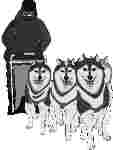 Ballad of A Sleddog
Ballad of A Sleddog
From the shadows of the past, And the Wolf I was tamed.
Across Siberia, to Alaska, and Greenland I came.
The people of this land called me Qimmiq by name.
But whether Husky or Malamute My spirit is the same.
I mushed for French fur trappers, the Mounties, and gold.
And I've done more for mankind then has ever been told.
From Dawson, and up the Yukon, To the Iditarod Trail,
Through blinding snow and bitter cold I hauled the mail.
On Gunner's sled with Balto in lead,
I brought the serum to Nome with life saving speed.
I went to the poles with Peary and Byrd,
But the credit was theirs, for little praise have I heard.
I'm the Iditarod champ, and king of the Quest,
For travel in the Northland I'm still the best.
I'll pull long in the harness from dusk until dawn,
Then I'll eat, and I'll rest, and again I'll be gone.
Around many a northern camp fire where tales are told,
There will be talk of a breed both courageous and bold.
The tale they will tell, is of the Traveler of The Cold.
-- Jim ChapekAddress questions or comments to at Nordikdog@aol.com
Return to Contents
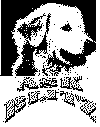
Ask Blitz: Canine Behavior Expert
Blitz has been a recognized expert in canine behavior for over six years. Both
parents were also behavior experts and passed this love of canine behavior
down to all their children. Our question this month is from a 3 year old female.
Dear Blitz,
My master says that I bark too much. He doesn't appreciate how hard I work to warn him of the
threats to our home. This neighborhood is rife with potential burglars and dog killers. I'm not
quite sure what a dog killer may look like but I'm sure that I've seen them in the neighborhood. If
a bad guy stole his precious television then it would be my fault for not guarding the house. What
can I do to make him recognize the problem that he refuses to see?
Signed,
Noisy in New England
Dear Noisy,
Canine communication has evolved from that of wolves. Wolves have dozens of specific sounds they make in response to various situations. These circumstances can range from non-specific such as howling to say "I'm here", to very definite situations like, "say, isn't that a little pig in a house made of straw?" With our domestication of humans, and the decline in the numbers of anthropomorphic pigs, dogs lost much of this verbal fecundity.
The northern working breeds, who have been denied access to word processors, may have even increased this vocabulary. These dogs frequently are made to pull heavy loads through the snow. (I hope this convinces the young puppies out there of the value of education.)
In humans, however, the verbal vocabulary has increased to the point that many humans fear that if they stop talking their heads will explode. This can be seen by how often they speak to you as if they expect you to obey. Just as you have to learn to understand your human, your human has had to learn to speak dog. Being basically simple creatures humans are unable to decipher more than the most rudimentary canine expressions.
Do this simple test. Tell your human about a potential TV thief in the backyard and observe how he cannot grasp even so simple a concept. Yet, you, through your superior intellect, know when your human expresses a desire to go for a ride or even to get some food from the kitchen (even if he has no intention of sharing with you). This further demonstrates the natural superiority of dogs.
Due to the remarkable trainability of humans they have been easy to domesticate. It is important to remember that humans are still monkeys in the core of their being. These latent simian traits mean that humans can sometimes appear almost canine in intelligence. Do not let this fool you. It is a common trap for dogs to expect too much out of their humans. This leads to disappointment and dominance challenges. Remember, you are the boss. If you let your human be the boss he will soon have you taking baths and getting stupid haircuts like a poodle.
So in closing, if your human does not understand the importance of what you are doing, you will have to train him better.
Good luck.
--Blitz.
Copyright 1996, Dan Wasson, All Rights Reserved.
Address questions or comments to at Blitzkuvas@aol.com
Return to Contents
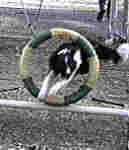
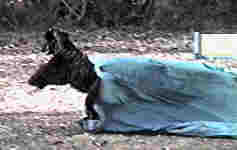
January 28, 1996Winter Games III were held in sunny, 50 degree weather at Mimosa Downs Agility Field on Super Bowl Sunday, January 28th, 1996.
There were 14 contestants in the first competition, the Hot Dog Dash. Cynda Byers and Bernie the English Shepherd were the big wieners. Scott and Maggie came in second place and Pam and Darcy, a black lab, finished third.
In addition to the Hot Dog Dash competition, there was an "ARF! sanctioned" agility titling
competition in which nine dogs received RAD (Rookie ARF! Dog) agility titles, and two dogs
earned EGAD (Extremely Gifted ARF! Dog) agility titles. All competitors received the Excellent
Dog Award.
Return to Contents

by Landen Gailey, Our Place or Yours Pet Services
As part of their registration for my group dog obedience classes, I ask students to write briefly what brought them to class, being as specific as possible. I frequently get an answer like this one: "I just want my dog to learn the meaning of the word NO!"
"NO!" is probably the most overworked word in our dogs' vocabulary. Make no mistake, there is a place for "NO!". Serious infractions such as lunging at another dog or at a person demand a stern response. But like the boy ignored as he cried "Wolf!", our "NO!" falls on deaf ears.
Pressing these students to tell me what they mean when they say "NO!" to the dog reveals part of the problem. People generally say "NO!" when they mean, "Stop whatever you are doing that I don't like!"
This means that a dog doing several things--such as barking, wagging its tail and shifting its feet excitedly--must be clairvoyant enough to realize just which thing is undesirable. Instead of using "one NO! fits all", clarify your wishes by teaching a specific descriptive commands. Teach "OFF!" for times when paws contact a person or object inappropriately. Teach "QUIET!" for excessive barking.
"NO!" is generally overused to the point that it carries little weight with the dog. When I ask my classes how many people have used the word "NO!" with their dogs, hands go up around the room. If you find yourself repeating "NO!" in ever escalating tones you probably have a dog who has learned to ignore the word altogether. Worse yet is the pooch who is so fixated on having YOUR undivided attention that he wags his tail and wiggles happily when you frown and chide him.
Rather than engaging in constant negativity and browbeating, owners can adopt new strategies. If your pooch is prone to overzealous greetings upon your return home, try this. Teach a clear specific command ("OFF!") to interrupt the assault. Then help your enthusiastic friend learn what kind of greeting behavior you DO want. Sitting to be petted, for example, is a less dangerous form of greeting. Substituting a desirable response will allow your companion the pleasure of continuing to show you how thrilled he is to see you without risking life and limb.
People often are very limited in their vocabulary with their dogs. Perhaps relying on "NO!" stems from laziness--it is just easier than remembering another command. Or perhaps its from the erroneous assumption that dogs are incapable of learning many words. Teach as many different words and commands as possible. And save "NO!" for the real emergency situations.
Copyright 1996, Landen Gailey, All Rights Reserved.
Address questions or comments to at OPOY@aol.com
Return to Contents
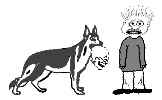
Dog owners are accustomed to having their beloved pets deposit gifts of dead birds and squirrels on their doorsteps, but a German Shepherd named Willie went too far.
According to televised news reports, Willie, while exploring in the woods near highway 162 in Newton County, Georgia, found a human skeleton and brought the skull home to a very surprised owner.
Scared me. I hollered at him and made him drop it, said the dogs owner. I went and got my mom and dad. I wanted them to see what I thought I saw.
Detectives found the rest of the skeleton about 100 yards away in the woods. At the time of this
report, the body had not been identified. Based on examination down at the crime lab, we found
that it appears to be the body of a white male, said Charles Roper, a detective on the case.
Return to Contents
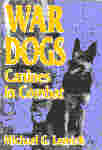
Reviewed by Steve Elftmann
Dogs are superior to humans in almost every way. For one thing, they don't start wars of massive destruction. Also, their sense of smell is about 40 times better than ours, they have superior night and distance vision, and their hearing surpasses that of humans. Given dogs' unique sensory capabilities, it shouldn't be surprising that in war, as in peacetime, dogs do amazing things.
"War Dogs" looks at individual stories of human and canine heroism. The focus of the book is on the need to honor these dogs and the desire to recognize how their contributions saved the lives of thousands of American soldiers. "War Dogs" is filled with fascinating pictures of canine soldiers - wearing gas masks, being parachuted from planes, alerting the Red Cross medics of a wounded soldier, scouting for enemy ambushes. The author is the official historian of the Vietnam Dog Handlers Association. With "War Dogs," he honors the 50,000 dogs who have faithfully served our country in wars.
One of those dogs, Chips, a German shepherd-husky-collie mix, became the only dog to be awarded a Purple Heart and a Silver Star for his incredible attack on an Italian pillbox when, acting alone, Chips forced the surrender of the machine-gunner and three other soldiers. After his famous act of heroism, Chips received a visit from none other than General Eisenhower, who tried to pet the dog and got his hand nipped.
Another war dog, Troubles, became separated from his handler in the middle of the Vietnam jungle. His handler had been injured and medevacked to a hospital ten miles away. Somehow, Troubles survived for three weeks in the jungle, eventually finding the new camp, ten miles away. Upon locating his handler's cot and equipment, Troubles, exhausted and emaciated, curled up and fell asleep next to it.
Each war dog is trained to perform a specific task, and "War Dogs" describes the variety of ways in which dogs have been used to aid the war effort. Scout dogs saved lives by detecting the presence of a hidden enemy, thus preventing soldiers from walking into ambushes. Sentry dogs alerted troops to enemy raids. Ambulance (or "mercy") dogs were used by the Red Cross to search out and rescue wounded soldiers. Messenger dogs delivered messages between units, often racing through enemy fire. Tracker dogs located areas of suspected enemy activity. Mine dogs found mines, booby traps, and trip wires so they could be avoided or safely detonated. Tunnel dogs located hidden enemy positions, in bunkers or tunnels. Sled dogs were used to locate and rescue downed airmen in snowy terrain. Draft dogs pulled carts of ammunition and supplies. Nor should we forget the mascot dogs, who provided companionship in the midst of the horrors of war and, though not officially trained, often performed unexpected acts of heroism.
But is it right to expose dogs to the horrors of man-made wars? In the preface to "War Dogs," the Mr. Lemish explains that "War Dogs" is not meant to glorify war, and asserts that "when dogs gave up their wild existence ages ago and forged an unparalleled bond with humans, their use as a military instrument was cast, creating a tradition spanning thousands of years." War is hell, for all species concerned and both humans and dogs were drafted and placed in life-threatening situations not of their choosing. Dogs were rarely given more dangerous assignments than their handlers (often the dogs were on leash, only a few feet away from their handlers), and military work dogs have generally been treated with respect and given proper care. The author deplores the use of suicide dogs, a practice used to this day by the Russian and Israeli armed forces, as unwarranted and unnecessary (and he also points out that the Japanese employed humans for suicide missions, but never used animals).
While many war dogs made the ultimate sacrifice, others survived battle, some even returning to useful civilian careers after war, such as the dogs that were re-trained to become seeing eye dogs after World War II.
In the final chapter, Mr. Lemish describes an incident that occurred in 1994 which demonstrates some of the difficulties encountered while attempting to honor these dogs:
During the crisp, clear morning of November 11, 1994, about one hundred of [the Vietnam Dog Handlers Association] gathered for memorial services at the Vietnam Veterans' Memorial in Washington D.C., as part of their first reunion.
Shortly before the ceremonies commenced, a man holding a German shepherd by a leash approached the stark black marble memorial. A uniformed National Park Service employee came forward and stopped the pair. "Sorry, sir, dogs are not allowed in the vicinity of the memorial," he said. The man looked up and in a clear voice stated, "I'm a former Vietnam dog handler and we are part of the service to be conducted here today." The ranger, with a quizzical expression on his face, just nodded and passed the man and dog through. For the first time since its dedication on November 13, 1982, a dog was allowed to participate in a ceremony at the memorial that most people refer to as simply "The Wall."
In spite of the underlying presence of war, dog lovers will appreciate and enjoy this book. They will recognize in these dogs the very qualities, magnified by adversity, that they find endearing in their own dogs - loyalty, devotion, courage, and an eagerness to serve man in all his endeavors.
"War Dogs" is available in bookstores, or you can contact the author directly at
k9writer@aol.com for information on how to get an autographed copy.
Return to Contents
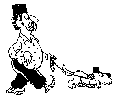
Return to Contents

God summoned a beast from the field and he said, "Behold man, created in my image. You shall protect him in the wilderness, shepherd his flocks, watch over his children, accompany him wherever he may go - even unto civilization. You shall be his ally, his slave and his companion."
"To do these things," God said, "I endow you with these instincts, uncommon to other beasts: faithfulness, devotion and understanding surpassing those of man himself. Lest it impair your loyalty, you shall be blind to the faults of man. Lest it impair your understanding, you are denied the power of words. Let no fault of language cleave an accord beyond that of man with any other beast or even with man. Speak to your master only with your mind and through honest eyes. Walk by his side, sleep in his doorway, forage for him, ward off his enemies, love him and comfort him. And in return for this, man will fulfill your needs and wants, which shall be only food, shelter and affection.
So be silent, and be a friend to man. Guide him through the perils along the way to the land that I have promised him. This shall be your destiny and your immortality."
So spake the Lord. And the dog heard and was content.
--Anonymous
Return to Contents
Where noted by copyright , articles in the ARF! Newsletter Online appear with the express consent of the author, who holds all copyrights. Any reproduction of this material, in whole or in part, is prohibited without the express consent of the author.
ARF! is a non-profit club with an all volunteer staff.